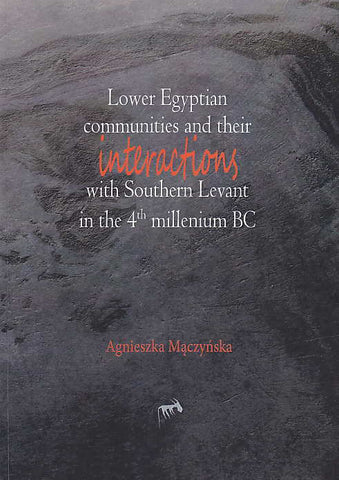Lower Egyptian Communities and Their Interactions with Southern Levant in the 4th Millennium BC
65,00 $
ISBN: 978-83-60109-33-5
Description: softcover, 251 pages (17x24 cm), figs. in text, 23 plates
Condition: very good
Weight: 650g.
A. Maczynska, Lower Egyptian Communities and Their Interactions with Southern Levant in the 4th Millennium BC, Studies in African Archaeology, vol. 12, Poznan Archaeological Museum 2013
This monograph is based on my doctoral dissertation written under the supervision of professor Lech Krzyżaniak and defended in the fall of 2004. Although many people encouraged me to publish the dissertation and the Council of the Faculty of History at Adam Mickiewicz University in Poznań, Poland, issued a positive opinion on the matter, I did not manage to have my thesis printed. Some of the issues addressed there were presented at conferences and published as research papers. In May 2011 I received a grant to finance a 3-year project entitled The Nile Delta as a centre of cultural interactions between Upper Egypt and South Levant in 4th millennium B.C. The grant was part of the Parent Bridge program financed by the Foundation for Polish Science, was aimed at providing assistance to young parents-researchers returning to research work after a parenting break. Publishing my doctoral dissertation was originally one of the project tasks. However, I well realized that archeological evidence and its interpretation had changed (sometimes significantly) after 2004. Likewise, my own views and knowledge had evolved during those years. It was thus only natural to update the dissertation and to revise my views presented back in 2004. As a result, this monograph is not merely an English translation of the dissertation defended nearly 10 years ago, but also addresses new discoveries from the Nile Delta and Southern Levant. In addition, it presents my current views on the interactions between the Delta, Upper Egypt and Canaan, reflecting the last two years of intensive research.
Preface
Acknowledgements
Introduction
1. Goals
2. Chronological range
3. Territorial range
4. Methodology
Part I - The Nile Delta and the Southern Levant in the 5th and in the first part of 4th Millenia BC
Chapter 1 – Key issues in and the current state of research
1. Overview of issues in and the state of research on the Predynastic period and the Lower Egyptian culture
2. Overview of issues in and the state of research on the relations between the Lower Egyptian and Southern Levantine communities
2.1. Relations between Egypt and the Southern Levant
2.2. Relations between Egypt and Sinai
2.3. Relations between Egypt and Syria/Mesopotamia
3. Summary
Chapter 2 – The Nile Delta in the Predynastic period
1. Background
2. Neolithisation process in Egypt
3. Predynastic period
3.1. Terminology
3.2. Periodization of the Predynastic period
3.2.1. Naqada culture
3.2.2. Early Predynastic cultures of Lower Egypt
4. Lower Egyptian cultures
4.1. Faiyumian culture
4.2. Merimde culture
4.3. El-Omari culture
Chapter 3 – Southern Levant in the Chalcolithic and the Early Bronze Age I
1. Chalcolithic period (4500-3650 BC)
2. Early Bronze Age I (3650-3000 BC)
Part II - Lower Egyptian Culture
Chapter 4 – Lower Egyptian settlement system
1. Settlements
1.1. Buto – Tell el-Fara’in
1.2. Maadi
1.3. Sais – Sa el-Hagar
1.4. Tell el-Farkha
1.5. Tell el-Iswid
1.6. Tell el-Masha’la
1.7. Tell Ibrahim Awad
2. Cemeteries
2.1. Heliopolis
2.2. Kom el-Khilgan
2.3. Maadi
2.4. Minshat Abu Omar
2.5. Wadi Digla
3. Summary
Chapter 5 – Lower Egyptian economy and social system
1. Economy
1.1. Farming
1.2. Animal breeding
1.3. Hunting, gathering and fishing
1.4. Summary
2. Social system
Chapter 6 – The Lower Egyptian ceramic assemblages
1. Pottery classification systems
1.1. Buto – Tell el-Fara’in, Ezbet el-Qerdahi
1.2. Heliopolis
1.3. Kom el-Khilgan
1.4. Maadi, Wadi Digla
1.5. Minshat Abu Omar
1.6. Tell el-Farkha
1.7. Tell el-Iswid, Tell Ibrahim Awad
1.8. Other sites
1.9. Summary
2. Technology
2.1. Raw materials
2.2. Vessel making process
3. Wares and forms
3.1. Wares
3.2. Vessel forms
3.3. Miniature vessels
3.4. Special forms
3.5. Miscellanea
4. Decoration
5. Vessel functions
6. Social aspects of pottery production
7.Summary
Chapter 7 – Other assemblages of the Lower Egyptian culture
1. Flint assemblages
1.1. Buto – Tell el-Fara’in
1.2. Ezbet el-Qerdahi
1.3. Heliopolis
1.4. Maadi – settlement
1.5. Maadi, Wadi Digla – cemeteries
1.6. Minshat Abu Omar
1.7. Tell el-Farkha
1.8. Tell el-Iswid, Tell Ibrahim Awad
1.9. Chaîne opératoire of the Lower Egyptian culture
2. Clay items
2.1. Buto – Tell el-Fara’in
2.2. Ezbet el-Qerdahi
2.3. Maadi – settlement
2.4. Tell el-Farkha
2.5. Tell el-Iswid, Tell Ibrahim Awad
3. Stone items
3.1. Buto – Tell el-Fara’in
3.2. Giza
3.3. Heliopolis
3.4. Maadi – settlement
3.5. Minshat Abu Omar
3.6. Tell el-Farkha
3.7. Wadi Digla
4. Metal products
4.1. Buto – Tell el-Fara’in
4.2. Heliopolis
4.3. Maadi – settlement
4.4. Minshat Abu Omar
4.5. Tell el-Farkha
4.6. Wadi Digla
5. Products of organic materials
5.1. Buto – Tell el-Fara’in
5.2. Heliopolis
5.3. Maadi – settlement
5.4. Maadi, Wadi Digla – cemeteries
5.5. Minshat Abu Omar
5.6. Tell el-Farkha
5.7. Tell el-Iswid, Tell Ibrahim Awad
6. Pigments
6.1. Heliopolis
6.2. Maadi – settlement
6.3. Minshat Abu Omar
6.4. Wadi Digla
7. Summary
Part III - Imports in the Nile Delta and the Southern Levant
Chapter 8 – Southern Levantine imports and their imitations in the Lower Egyptian culture
1. Buto – Tell el-Fara'in
2. Heliopolis
3. Maadi – settlement
4. Maadi, Wadi Digla – cemeteries
5. Minshat Abu Omar
6. Tell el-Farkha
7. Tell Ibrahim Awad, Tell el-Iswid
8. Summary
Chapter 9 – Egyptian imports at the Chalcolithic and the Early Bronze Age I sites in the Southern Levant
1. Pottery
2. Stone and flint items
3. Miscellanea
4. Summary
Chapter 10 – Lower Egyptian communities and their interactions with Southern Levant in the 4th millennium BC. Summary
References
Plates
List of tables
List of figures
List of plates

